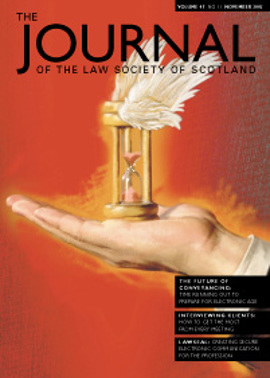Plain speaking
Overview
This column is a quick introduction to document design. By “document” I mean text on a printed page. (Different considerations – and techniques – apply for the web.) As lawyers, we deal with various documents and we can apply the guidelines to all of these. Even the humble letter should benefit.
In the beginning was the typeface
There are two groups of typeface:
- Serif. This text is – or should be! in a serif typeface.
- Sans Serif. But this text should be in a sans serif typeface.
According to Garner “a readable typeface probably means a serifed typeface”. However, the Plain English Campaign’s guide says “it is usually best to stick to sans serif”. I believe it’s less important to worry about “serif” or “sans serif” than it is to stop and check the typeface you are using is a readable typeface. So, not only should you be checking the font but also the size of the font.
Space
As a generalisation, the more white space, the better. Use good-sized margins and leave plenty of space between paragraphs and sections. Don't be afraid to start a new page for a new section.
Divide and Conquer
You can make a document easier to read and navigate by using headings. If you want to be even bolder, you can use sub-headings. What you are doing is breaking the text down so the reader can enjoy your writing in bite-sized pieces instead of intimidating him with one long stream of consciousness.
Take a look at most of the Court of Session decisions appearing on the excellent Scottish Courts’ web site. While some might say judges do not go far enough in making their decisions attractive and easy to read, how much more difficult would it be if the headings weren’t there? And take a look at some of the letters you receive in the morning mail, or letters you send to clients or colleagues. Could you improve them by using headings and sub-headings? Clients will appreciate the effort.
Listing and Bullets
Another way to improve a document is to set out key points as a list or use a bulleted presentation. For example, here’s the list I use when teaching basic letter writing techniques:
- Tell the client what has happened.
- Tell the client what is happening.
- Tell the client what will happen next.
You should develop your own style when it comes to using bulleted points. For example, Garner recommends you indent the bullet point, but I doubt that is essential. However, I would highlight one practical use of bullets in client letters. I use bullet points and graphics to draw a client’s attention to action points. For example, if I write to a client I may suspect he will only scan the letter – no matter the attractive layout – when I need him to respond or provide information about or deal with selected items. So, I might include this as one of the opening paragraphs: “I have used this symbol to highlight action you need to take.”
If nothing else, this layout is a good discipline for me as the writer. It forces me to double check what I am asking my client to do. And, in practice, the client will focus on what’s important. The lawyer and the client benefit.
Short Lines
It’s harder to read text with too many characters. If your brain doesn’t give up halfway across the line, your eye might. And you can easily lose your place as you read from the end of one line all the way back to what you hope is the start of the next line.
Garner recommends 45 to 70 characters in a line of text. The Plain English Campaign’s guide recommends roughly the same. Unfortunately, while letters might match the effective limit of 10 to 12 words a line, few contracts do. You should consider using a double column format for consumer type contracts. For other contracts, you may drastically improve readability by increasing the margin on one or both sides.
Closing
It’s easy to make a real difference in the readability of your documents if you make the effort. You can make a start by taking the time to notice the design of documents - this Journal for example! – and perhaps using some of the techniques in your next creation.
In this issue
- Opinion
- The future of conveyancing
- Don’t underestimate the value of people skills
- Lawseal promises secure electronic communication
- Pragmatic approach in going to proof
- Creating the most positive relationships
- Website reviews
- Nothing but the net
- Technology to the rescue?
- In practice
- Plain speaking
- Book reviews






